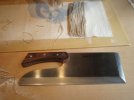- Joined
- Jan 10, 2015
- Messages
- 1,673
What if you add one more wheel ? Something like this ?

There must be a hundred possible variations. Yours above is trying to maintain the hair-pin turn on the small wheel and also get maximum wrap around the drive wheel?
It would probably interfere with the platen mount I have planned. Also, adding another wheel complicates the design that much more, and it's already a little complicated.


